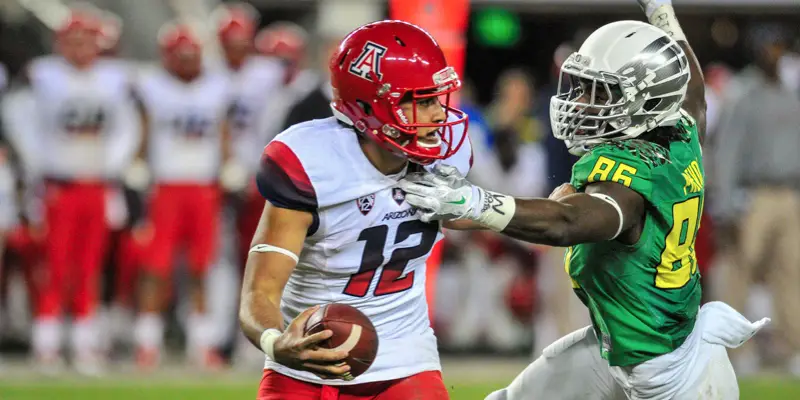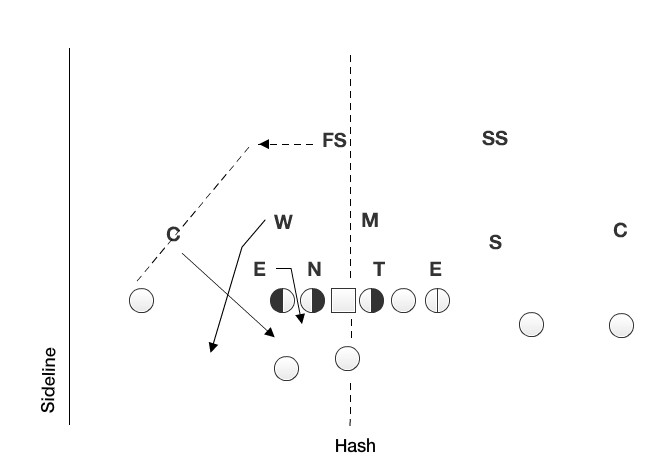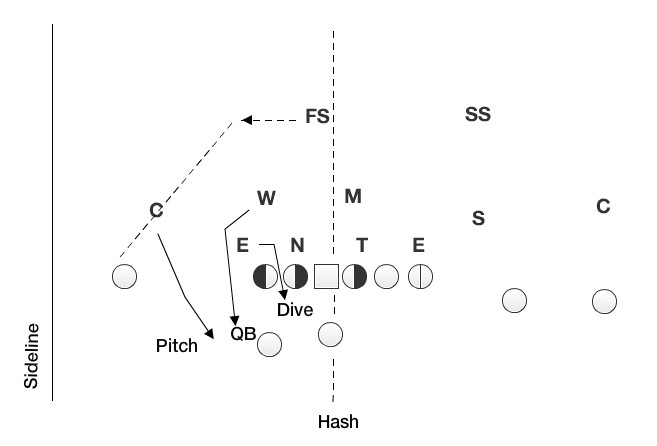Note from Principal: Instead of the usual analysis I provide, I felt that Coach/Analyst Alex Kirby did a superb job explaining a blitz strategy never covered on FishDuck.com before, and would be something to watch for against Florida State. Enjoy learning as I did! Charles Fischer
————————————————————————————-
There’s an oft-repeated maxim, especially among today’s football color commentators, that says, “Blitzing an offense is always a risky affair.” Sending more men than the offensive line can handle may sound like a good idea, but what about all those poor souls left on islands back in the secondary? An experienced quarterback who has the benefit of a decent offensive line will either sense the blitz before the snap and check to a more favorable play, or even if initially caught off guard, can buy enough time in the pocket to find a receiver left open by the defense. The receiver who makes the catch is usually just a broken tackle away from picking up big yards after the catch, and making the opposing defensive coordinator think twice next time before he decides to bring extra men.
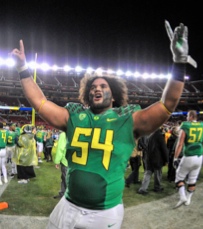
Hamani Stevens will have a new challenge in FSU.
Or at least that used to be the case. These days, bringing pressure from the linebacker and secondary positions is not the high-risk proposition that it is often made out to be. The modern college defensive coordinator has become less of a riverboat gambler, and more of a hedge fund manager. Instead of foolishly sending the house and betting the farm on every single play, he determines the acceptable level of risk and balances that with a sound scheme that doesn’t allow for easy completions by the offense.
Florida State defensive coordinator Charles Kelly is one such coach. A year after ending the SEC’s string of eight consecutive national championship victories, this Seminole defense is poised to cement its place in college football history. Kelly is known for bringing lots of pressure from all directions, so let’s talk about some of his favorite ways to slow down opposing offenses.
Start at the Boundary
For the uninitiated, when coaches refer to the boundary, it usually means the space between the sideline and the hash where the ball is currently spotted. Once the offense gets out into the middle of the field, defenses will base things more on the strength of the formation. This is one of the biggest schematic differences between the college game and the pros, and one that rarely gets talked about. While this subject alone could fill volumes, I’ll attempt to sum it up in the next couple of paragraphs.
Simply put, defensive coordinators want to force offenses into playing in close quarters. The boundary is where most college coordinators get the most creative. They can show all kinds of looks before the snap with the corner and/or linebacker to that side, and still have the ability to move to a more vanilla scheme once the ball is snapped, if they so choose.
What makes the boundary so special? In a word, space – or more specifically, there’s a whole lot less of it to defend.
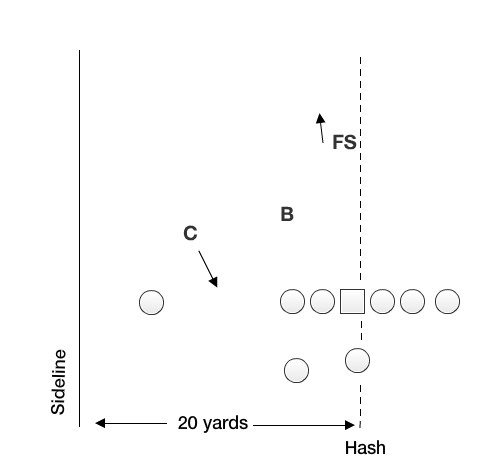
With less space to worry about to the boundary, defenders can afford to be much more reckless with their pre-snap looks, while still maintaining the ability to play sound, conservative pass coverage.
The distance from the hash to the sideline on a college football field is 20 yards, and only 11 yards between the top of the numbers and hash. Compare that with just over 33 yards from one hash to the opposite sideline. Since most offenses line their receivers up somewhere in relation to the numbers near the sideline, that means that defenders have a much smaller area to worry about compared to the men that are lined up to the ‘field side’ of the formation. Defensive players, especially the corner to the boundary side, can afford to be a lot more aggressive with their pre-snap disguises, especially by coming off their tight alignment over the receiver and showing a blitz.
So how does the quarterback have any idea whether the corner is really coming or just bluffing?
Boundary Corner Blitz
There’s a saying among coaches and hardcore X’s and O’s enthusiasts, and it usually goes something like this: “Safeties never lie, corners always lie.” While this is admittedly a pretty broad generalization, it’s a good starting point for young quarterbacks who are just beginning to understand coverages and pre-snap looks. It’s also important to remember when examining the types of looks that a defense is most prone to blitz from.
As you can see from the diagram above, the defense’s intentions are made much clearer by the position of the safety. It might not seem like much, but often times the difference between a bluff-look and a real corner blitz is made clear by only a few steps. In most two-safety looks, the safety to the near side will line up just on or to the inside of the hash (toward the middle of the field). In this way, he is better able to play a two-deep zone responsibility, and can also rotate to the middle of the field for a single-high look just before the snap. Conversely, a pre-snap alignment outside the hash marks and toward the sideline is an almost guaranteed sign of some kind of pressure coming from the boundary.

Marcus Mariota studies the defense.
The reason is that someone will have to fill the void in pass coverage left by the blitzing corner, and the safety to that side is usually in the best position to do it. Offenses have several options when deciding how to deal with a corner blitz, and one of the most common answers is for the QB to get the ball in a hurry to the receiver whose defender just blitzed. It’s called a ‘sight adjustment’, and it’s pretty common. The offense may also try to throw the ball deep to that same receiver before the near safety gets over to cover.
In either scenario, it’s the near safety that has to make the adjustment, and so naturally he’ll have to start a little closer to the sideline before the ball is snapped if he wants to get where he needs to be on time.
Stopping the Run
There is more to calling a blitz than just sacking the QB. Many college defensive coordinators, including Charles Kelly at Florida State, make regular use of run blitzes – so named because they are designed to, well, stop the run.
Things can get even more specific, especially when playing against a team such as Oregon, which has the ability to run all kinds of option plays. As a results, blitzes like the ones in the diagram below are common, with each player having a specific responsibility in stopping the run.
As you can see, the defensive end to the side of the blitz will slant into the B-gap while attempting to take away the dive player, usually the tailback. Next up is the Will linebacker in this scenario, looping around the edge and ready to play the QB should he choose to keep it on the option. Finally, the corner will take a slightly wider path in this instance, and will take on the pitch man in any triple option look to that side. Against a normal zone read scheme with no pitch man, the corner will act as a bonus guy against the run, once again taking a wider, more upfield path to force the ball carrier back into the teeth of the defense and make it nearly impossible to gain the angle on the defense to that side of the field.

OL Coach Steve Greatwood has his hands full.
That’s all well and good, and every defense looks brilliant when it’s drawn up against an offense on the blackboard, but what happens if the offense decides to pass? What changes for the defense? The simple answer is, not much. Keep in mind that many offenses today have the ability to throw the ball to an open receiver whether the play was originally called a run or a pass, so it’s best not to second guess or over-think things and just go full speed. At the end of the day, even against a pass, these sort of blitzes still have the ability to get heat on the quarterback, so the important thing is for the defensive players to execute their assignments quickly and efficiently.
Conclusion
From these limited examples, we can see that the blitz is more than just sending men after the QB with reckless abandon. Like many other things in football, a sound blitz scheme is controlled chaos, with each man on the field executing his job at a high level, and being able to adjust on the fly if needed.
In the next part of this discussion, we’ll break down some of the ways FSU D-Coordinator Charles Kelly could bring pressure from the opposite direction, this time from the field, in order to try to stop the vaunted Oregon offense.
Top Photo by Kevin Cline
Alex Kirby regularly writes at LifeAfterFootballBlog.com and is the creator of DrawFootballPlays.com. You can find his book Speed Kills: Breaking Down the Chip Kelly Offense on Amazon.com in Paperback or Kindle format.
Alex Kirby (Writer and Football Analyst) worked several seasons as an assistant football coach at the high school and college levels and is the author of Speed Kills: Breaking Down the Chip Kelly Offense, now available HERE.

